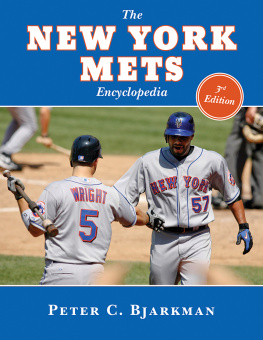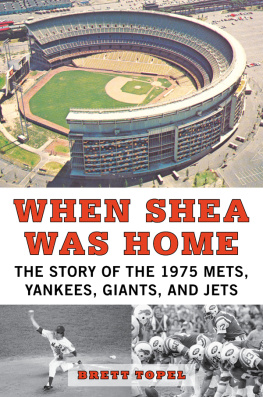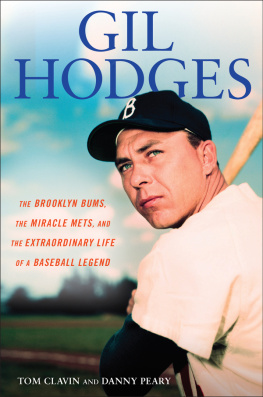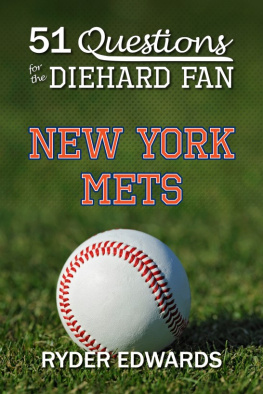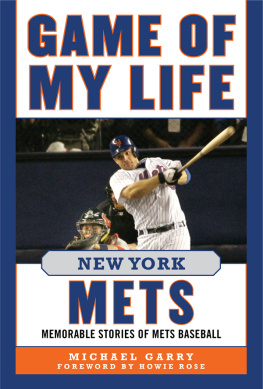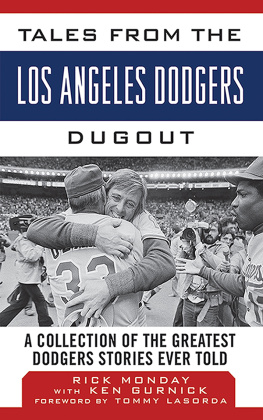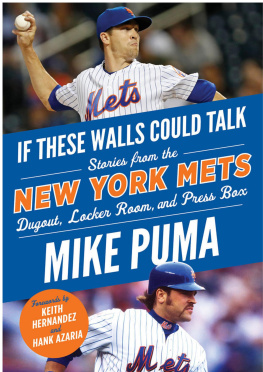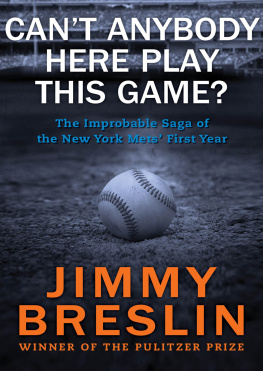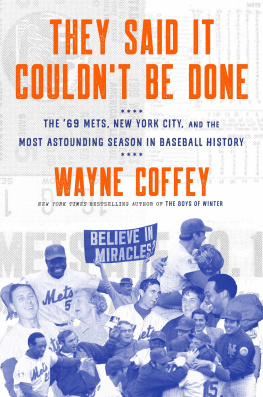To the 1962 Mets, who did more for baseball with 120 losses than most teams do with 120 wins.
And to Hilda and Seymour Weingarten, the best baseball fans I know.
Copyright 2004, 2012 by Janet Paskin
New material copyright 2012 by Skyhorse Publishing, Inc.
All Rights Reserved. No part of this book may be reproduced in any manner without the express written consent of the publisher, except in the case of brief excerpts in critical reviews or articles. All inquiries should be addressed to Sports Publishing, 307 West 36th Street, 11th Floor, New York, NY 10018. Sports Publishing books may be purchased in bulk at special discounts for sales promotion, corporate gifts, fund-raising, or educational purposes. Special editions can also be created to specifications. For details, contact the Special Sales Department, Sports Publishing, 307 West 36th Street, 11th Floor, New York, NY 10018 or .
Sports Publishing is a registered trademark of Skyhorse Publishing, Inc., a Delaware corporation.
Visit our website at www.sportspubbooks.com
10 9 8 7 6 5 4 3 2 1
Library of Congress Cataloging-in-Publication Data is available on file.
ISBN: 978-1-61321-080-2
Printed in the United States of America
ACKNOWLEDGMENTS
W hen Sports Publishings Mike Pearson asked me to write this book, I told him I could only agree if the members of the 1962 Mets Id met while working on a story for The Journal News gave me their blessing. They did more than that. I am grateful to each of the players who took time to talk to me, especially Craig Anderson, Larry Foss, Solly Hemus, Jim Hickman, Jay Hook, Al Jackson, Sherman Jones, Rod Kanehl, Clem Labine, Ken Mackenzie, Felix Mantilla, Herb Moford, Frank Thomas, and Don Zimmer. Marv Throneberrys widow Dixie and Harry Chitis widow Catherine were also helpful, as were Bob Mandt, who started as a Mets ticket salesman and worked his way up to vice president, and broadcasters Ralph Kiner and Bob Murphy.
The sportswriters who covered the Mets were as important as the players in making the 1962 season special. Maury Allen, Stan Isaacs, Steve Jacobson and Jack Lang are engaging storytellers and were generous with their time.
The staff at Baseball Hall of Fame research library was eminently resourceful and helpful.
I am indebted to Mike Pearson, who invited me to do this project, and to editor Kipp Wilfong, who made the entire experience a pleasure. The folks I work with and for at The Journal News were supportive throughout, especially Mark Leary, Susie Arth and Mike Rose. Special gratitude is due Jennifer Friedman, Kathryn Schulz, Craig Aaron, Laura Paskin, Barry Mendelsohn, Ron Paskin, and Nancy Hammer whom I am lucky to have both as readers and very much loved friends and family.
FOREWORD
ASHBURN TO PASCUCCI
By Greg W. Prince
T he 1962 Mets are eternal. Like The Joe Franklin Show after an extra-inning West Coast night game, you can join them already in progress. The 1962 Mets transcend the year of their birth. They were still going on in 2011. Felt like it, at any rate.
Consider the final nine games the 2011 Mets played, particularly as bookends to the first nine games their 1962 forebears rolled out.
In the beginning there were nine games that set the tone for what standsdespite two far-off world championships impossible to envision when Casey Stengel was stirring the primordial soupas the most legendary season in franchise history. Certainly the 1962 Mets yielded more legends per win than any ballclub in history, and many of them are told and explored in this book.
In between there was the bulk of a half-century of New York Mets baseball. A little of it was extraordinarily successful. A little too much of it was nothing of the kind.
At the end there was
Well, assuming they were still partaking of the Metropolitan Experience as a 77-85 2011 season drew to a close, Mets fans who tuned in to SNY or ponied up to attend Citi Field during the final week-and-a-half of yet another sub-.500 season experienced frustration, aggravation, and exultation in roughly equivalent proportions. As Meat Loaf might have advised, had he been predisposed to ask Bob Murphy rather than Phil Rizzuto to guest on Bat Out OfHell, one out of three aint bad. (The Mets fan mindset is forgiving that way.)
Over the course of the last nine games of their teams first 50 years of existence, the faithful were served a Pu Pu Platter typical of the baseball fare the Mets had been churning out across 2011 and other less than legendary campaigns: a dash of hope, a pinch of excitement, a heaping helping of dismay, and an unlimited supply of clean plates so a person could, whether out of loyalty or reflex, queue up for More, please.
That person who watches lousy teams finishing being lousythe reflexively loyal and the loyally reflexivein other words, a Mets fan.
Frustration
If you were among the 2011 dead-enders (as I sure was), you saw the Mets do what the Mets do more years than not. They played out the string long after the string had lost interest in them, meeting their scheduled commitments against the Cardinals, losing two of three against a contender fighting for an unlikely playoff date; the Phillies, winning two of three from a rival tuning up for October; and the Reds, losing two of three to an also-ran like themselves. These were nine games for which there were perfectly defensible reasons to watch, though you couldnt be faulted for looking away out of self-preservation. Engagement in the final nine games of seasons of teams whose feeding tubes are days from being removed are intended for neither the dilettante nor the squeamish.
Still, there was plenty to pile on your plate besides poor relief pitching, sporadic clutch hitting and the perpetually stunted development of 6-foot, 7-inch Mike Big Pelf Pelfrey.
The Mets did a little prospective spoiling in St. Louis via a six-run, ninth-inning comeback that actually wound up spoiling nothing for the World Series-bound Cardinals yet appeared satisfyingly lethal at the moment of contact.
They secured the franchises first batting crown in front of the home folksthough not without angst, as Jose Reyes bolted his clinching game against the Reds quickly and murkily.
And, because they cant help themselves, they flirted with their first no-hitter before letting that coveted brass ring slip through their fingers.
This latest attempt at nixing a 50-year-old jinx was engineered for six-and-a-third almost flawless innings by postgame intellectual R.A. Dickey, the knuckleballer who tosses off words like inconsequential to reporters the way other players spit sunflower seeds. Its just what he doesthat, and pitch with little run support. Dickey kept up his end of a nothing-nothing Saturday afternoon standoff against Cole Hamels and the Phillies until there was one out in the seventh, when Shane VictorinoHawaiis reminder that not everything it exports to the mainland is as delightful as luaus or Benny Agbayanidoubled.
There went the no-hitter, as Mets fans are used to saying, assuming they could hear themselves mope over the surfeit of invading Phillies fans. And next went the tie, when the subsequent hitter, Ryan Howard, singled home the Wailuku pest. There went yet another game in yet another season, it seemed, as the StubHub-enabled hordes from down the Turnpike were ascendant once again in Flushing.
Aggravation
The matinees real story, however wasnt destined to be told by a Victorino, but by a Valentino. That would be Valentino Pascucci, an immense, clunky, righthanded Triple-A slugger who bashed 34 home runs as recently as 2007 yet, prior to September 2011, hadnt collected major league meal money in seven years.


